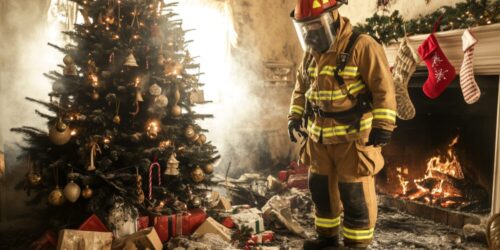
12.5.24 – SSI – SSI Staff
U.S. fire departments responded to an annual average of 835 home structure fires that began with Christmas decorations from 2018 to 2022.
QUINCY, Mass. — Christmas trees, holiday decorations, and festive meals – hallmarks of the holiday season – present potential fire hazards that collectively contribute to an increase in U.S. home fires each December.
According to the National Fire Protection Association (NFPA), Christmas Day and Christmas Eve were the second- and third-leading days of the year for home cooking fires, respectively, in 2022.
“When people are busy and trying to do many things at once, they’re more likely to get distracted from what’s on the stove or in the oven,” says Lorraine Carli, NFPA vice president of outreach and advocacy, in the association announcement.
“Knowing that unattended cooking is the leading cause of home cooking fires year-round, it’s easy to see why the number of cooking fires spikes on these days,” she says.
Candles and Lighting
Decorating homes with electrical lighting and candles also contributes to a higher fire risk during the holiday season, according to the NFPA announcement. Between 2018 and 2022, U.S. fire departments responded to an annual average of 835 home structure fires that began with decorations (excluding Christmas trees).
Year-round, approximately one-third (32 percent) of home decoration fires were started by candles; in December, that number jumped to almost half (46 percent).
Christmas Trees Can Cause Serious Home Fires
Christmas tree fires don’t happen very often, but when they do, they tend to be more serious. An annual average of 155 home Christmas tree fires resulted in four civilian deaths, seven civilian injuries, and $15 million in direct property damage, with electrical distribution or lighting equipment involved in more than two in five home Christmas tree fires.
Lithium-Ion Batteries
Many people will be buying and gifting electronic devices that contain lithium-ion batteries. As the use of these devices has increased in recent years, so too has the number of related fires. It’s important to understand the risks associated with these batteries and ways to prevent them:
- Only purchase and use devices, batteries, and charging equipment that are listed by a nationally recognized testing lab and labeled accordingly.
- Use charging equipment that is only compatible with your device. To be safe, use only the charging equipment that is supplied with your device.
- Do not keep charging the device or device battery after it is fully charged.
- Do not put lithium-ion batteries in the trash. Recycling is always the best option. Take the batteries to a battery recycling location or contact your local waste department for disposal instructions.
- Stop using your device if the battery shows signs of damage, such as an unusual odor, excessive heat, popping sounds, swelling, or change in color.
- Only have device repairs performed by a qualified professional.
“The commonality between the vast majority of all these fires is that they’re largely preventable,” says Carli. “By understanding when and where potential risks exist, people can take simple steps to reduce their likelihood, which can go a long way toward ensuring a festive, fire-free holiday season.”
